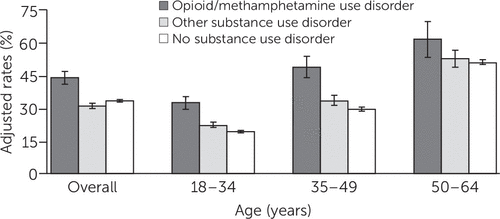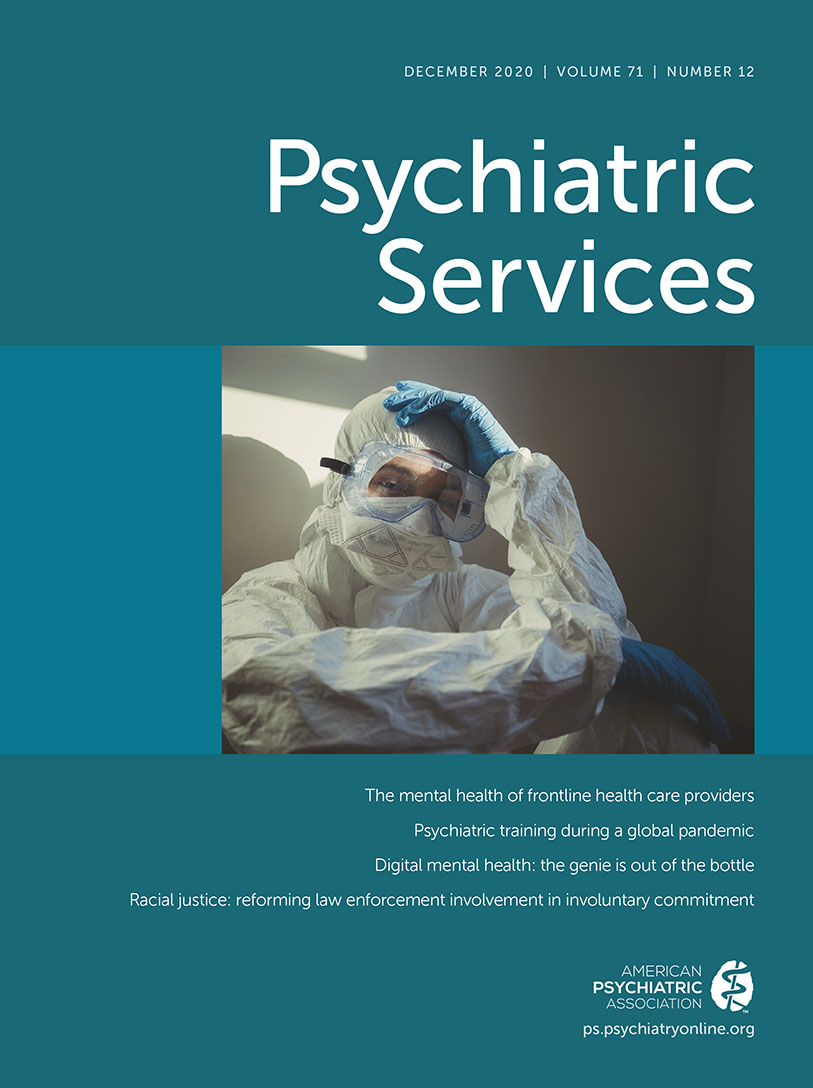Clinical Risk Factors for COVID-19 Among People With Substance Use Disorders
As COVID-19 spreads across the United States, people with substance use disorder may be susceptible to contracting the disease and developing serious complications. COVID-19 epidemiology suggests that cardiovascular and chronic respiratory diseases and diabetes may increase the risk for severe illness (1). People with opioid use disorder and methamphetamine use disorder deserve particular attention, given the detrimental effects of long-term drug use on pulmonary function, other major organ systems, and the immune system (1).
We used individual‐level data from the 2015–2018 National Survey on Drug Use and Health (NSDUH). Our sample consisted of three mutually exclusive groups of civilian, noninstitutionalized adults ages 18–64: those with past-year opioid or methamphetamine use disorder, those with other types of past-year substance use disorder (i.e., abuse of or dependence on alcohol, illicit drugs other than opioid and methamphetamine, or both), and those who did not have a past-year substance use disorder (2).
We used logistic regression models to estimate differences among the groups in the overall and age-stratified rates of having an underlying condition that may heighten the risk for severe illness following COVID-19 infection. Models were adjusted for gender, race-ethnicity, and urban/rural residence. We used the Stata/SE “svy” procedure to account for NSDUH’s sampling weights and complex survey design (2).
Nonelderly adults with opioid or methamphetamine use disorder were most likely to have an underlying condition (adjusted rate, 44.2%; p<0.001), compared with those with other types of substance use disorder (31.4%) and those without a past-year substance use disorder (33.5%). The higher rates of having an underlying condition among those with opioid or methamphetamine use disorder were observed consistently across all age categories (Figure 1).

FIGURE 1. Adjusted rates of having clinical risk factors for COVID-19 severity and mortality among nonelderly U.S. adultsa
aClinical risk factors recognized by the World Health Organization and the Centers for Disease Control and Prevention and included in the National Survey on Drug Use and Health questionnaire are cardiovascular disease, hypertension, chronic respiratory diseases, diabetes, cancer, chronic liver diseases, kidney disease, and HIV/AIDS. Rate estimates and 95% confidence intervals (whisker lines) were estimated with Stata/SE.
Our findings underscore that opioid and methamphetamine use disorders are associated with underlying conditions identified as risk factors for COVID-19 severity and mortality. People with these conditions are an underserved group who may need additional support to ensure equal access to testing and treatment, especially as COVID-19 continues to impose unprecedented pressures on the nation’s health care system. Social distancing, self-quarantine, and other public health measures may disrupt their access to addiction treatment (2). Additional efforts are required to mitigate those unintended disruptions.
1 . Collision of the COVID-19 and addiction epidemics. Ann Intern Med (Epub ahead of print, April 2, 2020).Crossref, Medline, Google Scholar
2 2018 National Survey on Drug Use and Health: Methodological Summary and Definitions. Rockville, MD, Substance Abuse and Mental Health Services Administration, 2019. https://www.samhsa.gov/data/sites/default/files/cbhsq-reports/NSDUHMethodsSummDefs2018/NSDUHMethodsSummDefs2018.pdfGoogle Scholar



